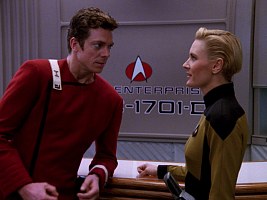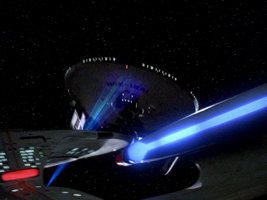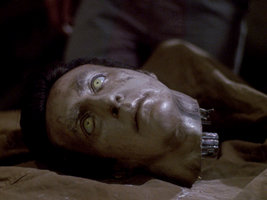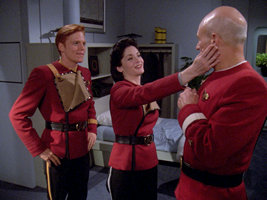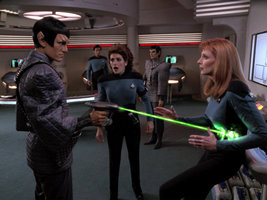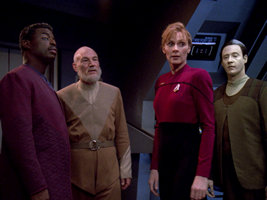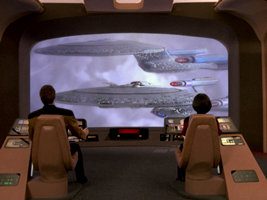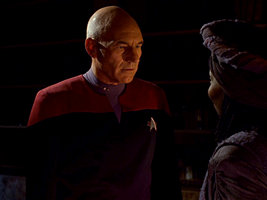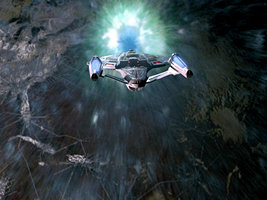Time Travel in Star Trek: The Next Generation (TNG)
"Let's make sure that history never forgets the name... Enterprise." (Capt. Picard, TNG: "Yesterday's Enterprise")
The Series
TNG: We'll Always Have Paris
This episode is full of "small" paradoxes where the characters encounter themselves in moments that are only a few seconds or minutes in the past or the future. The problem is basically the same as with the grandfather paradox, although the impact is of course less severe.
Classification: random time shifts, without visible consequences
TNG: Time Squared
In this episode Picard 2 is the only one to survive the explosion of the Enterprise. He is thrown six hours to the past together with his shuttlepod. Aboard the still existing Enterprise in the past, Picard 2 suffers from a severe shock; he initially cannot talk and doesn't remember anything. Moreover, the shuttle's computer data cannot be read out. It is clear that this is primarily a ploy to keep the situation obscure. Anyway, the effects shown here are doubtful with regard to other time travel episodes. The difficulty with the shuttle's energy signature may be rationalized with some technobabble. Picard 2's corresponding physical and mental condition, however, seems to be directly related to the current time, as if there were a temporal signature of his organism that makes him feel better the closer he is to the time of his departure (ironically, only to vanish the very moment that marks his departure to the past). This doesn't make much sense, considering that whatever is responsible for biological and electronic systems being out of phase here, the phase shift remains the same as long as they remain in the wrong, earlier time frame. What's more, there is no such effect in other episodes, only a weak similarity to TOS: "All Our Yesterdays".
It is ethically highly questionable for our present Picard 1 to kill his ill-fated counterpart from the future. It would have been absolutely sufficient to hold him back, since "the cycle must end", as Picard 1 notes himself. Ironically, after changing the timeline in this direction, Picard 2 disappears anyway together with the shuttle. There is an obvious paradox when the Enterprise does not explode, since in this case there is no Picard to travel back in time and warn the Enterprise.
Classification: broken predestined timeline ("causality loop"), with biological impact of time travel
TNG: Yesterday's Enterprise
When the Enterprise-C appears from the space-time rift, the ship has traveled "22 years, 3 months and 4 days" into the future, according to Data. The timeline from the instant of its departure in the year 2344 to the present of 2366 is instantly switched. It can be supposed that the Klingons regarded the disappearance of the ship from Narendra III as cowardice, which finally led to the war timeline. The Enterprise-D crew, as almost all other beings in the galaxy, are unaware of the change, even as Worf is replaced by Tasha. It remains a mystery how Guinan is able to perceive the old timeline, which has not been "simply" erased from biological and computer memories, but has actually never existed. No one would expect a biological entity to have such a supernatural ability, which is absolutely useless for its normal life. One would rather suppose that beings such as Q who move in more than three dimensions can perceive and also manipulate timelines. Maybe Guinan is not the humanoid she appears to be.
Apart from the temporal sequence, there is also a logical sequence of events.
1. The Enterprise-C defends the Klingon outpost and is finally destroyed (event 1), which is honored by the Klingons (timeline 1).
2. The Enterprise-C is "pulled" into the future of 2366 prior to being destroyed (event 2), which infuriates the past Klingons and creates the war timeline 2. The space-time rift is not a static phenomenon, but originates at event 2, since until then the old timeline 1 definitely existed.
3. The Enterprise-C is "pushed" into the past again. This allows to recover event 1, but not exactly, since Tasha is aboard the Enterprise-C.
4. The Enterprise-C defends the Klingon outpost and is finally destroyed, which is honored by the Klingons (event 1a). Some crew members, among them Tasha, are "saved" by the Romulans, only to be killed later on. However, Tasha gives birth to her daughter Sela, who will appear later in TNG: "Redemption" and "Unification" (timeline 1a).
It is not evident why the Enterprise-D is present near the very same spatial anomaly in both timelines 1/1a and 2, despite the vastly different circumstances. This was a dramatic choice, but must be rated as extremely unlikely because of the second law of thermodynamics. For the same reason, the crew of the Enterprise-D and ultimately the ship itself shouldn't be so very similar in both timelines. Unfortunately, it is not an option that the timelines could have diverged slowly (we might imagine that in 2364 an important Klingon figure suddenly made a big deal about what happened in 2344 and started the war). Picard explicitly speaks of "20 years of war".
The even bigger problem with this episode arises retrospectively. The temporary timeline 2 should have been eliminated by sending back the Enterprise-C to the past. This would not have allowed Tasha to stay aboard the Enterprise-C, she would simply disappear at the instant the future is changed again, and Sela could never exist. Vice versa, Captain Garrett, who died in a never existing future, would come to life again (for a short time). This is an obvious paradox. Perhaps the Enterprise-C, returning from the future, is shielded in some fashion so it would not be returned to the state in which it left the year 2344.
Classification: past incursion caused by accidental travel to the future, remaining paradox (Tasha and Sela)
TNG: Captain's Holiday
Time travel is only a secondary aspect of the story, although the Tox Uthat is assumed to come from the future. However, this is one of the few episodes where a predestined timeline is established, since the two Vorgon time travelers obviously anticipated that Picard would destroy the Tox Uthat.
Classification: predestined past incursion ("causality loop")
TNG: A Matter of Time
No paradox occurs in the episode itself. However, by leaving his own time which is in fact the 22nd century, Rasmussen has probably already altered history. On a side note, it does not become clear why Rasmussen, who has a timeship from the 26th century, chose the less advanced 24th century to steal technical equipment. What's more, for an ordinary thief he seems to be too well prepared, since he knows or pretends to know a lot of details about the Enterprise. As much as he has learned about it, there should have been much easier ways for him to get hold of valuable equipment than on the well-guarded starship.
Classification: intentional past/future incursion, without visible consequences
TNG: Cause and Effect
This episode features two different kinds of time travel. First, the USS Bozeman unintentionally travels 90 years to the future, just to collide with the Enterprise. Second, the Enterprise is caught in some kind of time loop. Every time the Enterprise is destroyed, the present time for ship and crew and probably the surrounding space region returns to an instant some time before the ship's destruction from an external viewpoint. In other words, the Enterprise and her crew do not travel back in time, but time itself is not continuous within a small region of space. This is corroborated by the statement that the Federation time signal is 17.4 days ahead at the end of the episode, meaning that the Enterprise has stayed in the time loop for this long as seen from an external observer.
The phenomena in this episode can't be explained in plain language. The starting point of the events seems to be a space-time rift, potentially similar to the one in TNG: "Yesterday's Enterprise". The Bozeman is pushed or pulled into the future through this rift and almost immediately collides with the Enterprise. The explosion of the Enterprise, probably in connection with the surrounding space-time distortion, causes the time reset. We do not know if the Bozeman explodes as well or is directly affected by the destruction of the Enterprise. However, it is obvious that the Soyuz-class ship is caught in the time loop as well, since the collision occurs repeatedly. Each time the Enterprise is restored to the state that was a few hours ago, and the same must apply to the rest of the space region. Otherwise, in the second and following laps the crew would have registered discontinuities in sensor measurements. We can assume that a Federation time signal is not continuously received, although this was possible in TOS: "The Naked Time". However, in any case the changes of remote constellations are definitely measurable and should have revealed the time reset. Since the Bozeman was not in the respective space region some hours ago, the ship is thrown back 90 years after each explosion; only this way it can emerge from the rift each time.
The story is substantially consistent if we accept the unlikely fact that humanoids have a built-in sixth sense for temporal discontinuities (déjà-vu) that Data as well as the advanced subspace-physics based equipment of the Enterprise do not detect. There is no paradox, since the repeated collisions and explosions actually happened. Still, the chance of a collision of the two starships is literally astronomical, even if we take into account that the Enterprise is somehow attracted by the space-time distortion.
Classification: time travel to the future & broken causality loop in an isolated region of space-time
TNG: Time's Arrow
There are two clear indications of a predestined timeline in this episode. First, Data's head is found in the cave before Data actually travels back to the past and loses his head. Second, Guinan pretends to know Picard for a long time, which is only confirmed "later" when Picard actually meets her in the past. If we assume that back in the past the crew create exactly the timeline that has always existed, whether they want it or not, this episode is self-consistent. Moreover, complicated explanations of switching between different timelines are not necessary, since there is only one timeline.
Nevertheless, the concept of predestination remains hard to accept because it is an offense against free will. What if Data had stayed away from the scene under all circumstances as Picard has originally planned it, in order to avert his time travel? Who could have hindered him to change history? Likewise, what if Picard had taken Data's head with him when he returned to the 24th century?
What's more, we have contradictory statements about the mechanism of time travel in this episode. After his head has been found in the cave, indicating that he will die, Data says: "There is no way anyone can prevent it, sir. At some future date, I will be transported back to nineteenth century Earth, where I will die. It has occurred. It will occur." He thereby explicitly states that the timeline is predetermined, in contrast to what happens in most of Star Trek's time travel episodes. Conversely, Guinan claims that there is nothing like predestination. She insists on Picard joining the away team, so she can meet him in the past. If everything were predestined, there would be no need for her to take any influence with her knowledge about the timeline. She also tells Riker on the topic of what he could do to save Picard who has stayed behind in the past: "If I told you what happened in that cavern, it would affect any decision you'd make now. I can't do that. I won't."
Classification: predestined past incursion ("causality loop")
TNG: Tapestry
Q may have forged the whole scenario much like a holodeck simulation. However, if we believe Q, then Picard is given a second chance to avoid the confrontation with the Nausicaans, in the course of which he lost his natural heart. Q sends him back to his early days in Starfleet, briefly prior to the incident.
Picard perceives himself as the aged captain, while everyone else sees the young Ensign Picard. At the end of the episode, when Picard is revived (for which he is rather indebted to Beverly than to Q), it is still not clear whether his experiences in the past were true. We might tend to believe Q, who has never been so honest and sympathetic than in this episode and will never be again. In this case, the past has been slightly changed, taking into account Picard's short affair with his crewmate Marta.
Side note The authors missed a great opportunity in connection with the TNG episode "Bloodlines", where Dai Mon Bok alters a boy genetically so that he appears to be Picard's son. The boy, however, could have been Picard's and Marta's real son and this could have proved that Picard really traveled to the past.
Q's promise that Picard can change his own history without affecting other people is odd in any case: "Since you attach so much importance to the continuity of time, I will give you my personal guarantee that nothing you do here will end up hurting anyone, or have an adverse affect on what you know of as history." In order to elude the butterfly effect, Q would have to "filter" Picard's actions with selective disregard for interdependencies and fabricate a history that could not exist on its own. Q's demonstration that Picard, at his current age, would still be a lieutenant junior grade instead of captain, only because he has always been cautious, is doubtful and it insinuates that there is something wrong about the whole scenario.
Classification: multiple intentional past incursions that possibly never took place, without visible consequences
TNG: Timescape
This episode features various time levels in which time proceeds at different speeds. The time on and around the Enterprise and the Romulan Warbird almost stands still relative to the time experienced by Picard, Deanna, Geordi and Data in the runabout. The concept and effect of time levels is similar as in TOS: "Wink of an Eye", however, the explanation is substantially different in the TNG episode. Here, the time levels are a physical phenomenon, and the effects of interaction between different time levels have to be considered on this level. There should be physical as well as biological problems for a character entering another time level. Yet, only the latter ones have are partially shown in the episode.
Further investigation of the implications shows that any interaction with a significantly different time level is virtually impossible. Firstly, light or any other form of energy coming from a slower time level is shifted to extremely low frequencies and also its intensity is significantly reduced. Geordi can hardly locate the frozen Enterprise because "energy levels are practically non-existent", yet it is possible to see everything like it were on a normal level. Realistically, even Geordi would not see the extreme infrared light. This is due to the simple fact that one corresponding oscillation period is many times longer in the slow time level than in the fast level. Secondly, the same applies to molecular motion, so the temperature would be very close to absolute zero for persons from the fast time level, and of course extremely uncomfortable. Thirdly, it is doubtful whether it is possible to touch or move objects in the slow time level or to breathe the molecules of the "slow" air, let alone to cope with their low temperatures. Finally, even if interaction is possible, for the slow computer it should take a long time until anything is displayed. The writers could have avoided at least the latter inconsistency by somewhat slowing down the LCARS response times.
Classification: different time levels
TNG: Parallels
This is one of the most fascinating Star Trek stories ever. It focuses on parallel realities, while the time travel at the end of the episode is only a secondary aspect. The time travel probably serves to return to the original timeline in "our" universe that would otherwise have been altered by Worf's temporary absence, or another Worf's presence.
Classification: travel to another reality and back in time, without visible consequences
TNG: Firstborn
We get no idea if and how the old Alexander's appearance in the past would affect his own time and himself. The grandfather paradox is quite evident, considering that young Alexander would be warned and probably wouldn't travel back in time in his later years.
Classification: past incursion, with unknown consequences
TNG: All Good Things
Q is well-known for his fancies, and of course it is him who arranges the weirdest time travel of Star Trek so far. Maybe he takes pleasure in sending Picard on time travels since TNG: "Tapestry". Firstly, three different times in the past, the present and the future are involved, and Q arbitrarily transfers Picard from one time to another. Secondly, Picard is transferred into himself, i.e. he replaces his alter ego in the past and the future. In a "normal" time travel there would be two simultaneous Picards. Thirdly, his actions in the past do not have any bearing on the future, the three times are isolated from each other with respect to the normal forward course of time. Finally, vice versa, the captain's actions in the future do affect the past. It seems that Q employs any possible trick to bring about the anti-time reaction that destroys all mankind in the past, only to blame Picard for it. Picard is only a marionette in Q's highly unfair fancy, however, despite all off Q's attempted deception, the best Star Trek captain ever does his job.
The fact that the Enterprise is destroyed in "Star Trek Generations" might be a sign that the TNG episode does not describe an actual future, but only a future in Q's imagination. However, in DS9: "The Visitor" another possible future is shown, and the future Defiant crew wear the same uniforms and badges as on the future Enterprise and Pasteur. Apart from the obvious budget savings in the real world, this is a sign that Q's future is not inevitably the real future, but at least a realistic one.
Classification: multiple travels to multiple times, corrected or without visible consequences
The Movies
Star Trek: Generations
The movie features the Nexus, a phenomenon that allows either to stay in the wonderful world inside or to travel anywhere any time. In other words, the Nexus can do everything. This quality is certainly not beneficial for the story, as it leaves too many options and too many questions. According to the Star Trek Encyclopedia II, Soran was only briefly inside the Nexus in 2293 until he was "rescued" by the Enterprise-B transporter beam. This assumption makes more sense than the theory that the El-Aurians were expelled from the Nexus by the Borg. Exactly the same as to Soran must apply to Guinan. However, while Soran seems to be outside the Nexus when Picard meets Kirk, there is a representation of Guinan left in the Nexus and able to talk to Picard.
Picard and Kirk probably chose the worst possible instant to leave the Nexus and return to reality when Soran already had his finger on the launch button. If it is true that the two could have traveled anywhere any time, they could have returned e.g. to the Amargosa Observatory. Captain Picard probably considered possible effects on the timeline, however, either he wanted to prevent the destruction of the inhabited solar system under all circumstances or not. In particular, Kirk could have chosen a better time for himself to return to reality. What if Kirk had gone back to his own time and probably changed history?
In this movie a paradox does not occur, because the Nexus probably works as a kind of buffer between the timelines. The Nexus is obviously a domain outside of our space-time, and is therefore not affected by changes in our universe. So the old timeline, in which the Veridian system and the Enterprise saucer are destroyed, ceases to exist. However, Picard is nevertheless always present in the Nexus (like Guinan), and so he is able to leave the Nexus and fight Soran in the new timeline.
Classification: past incursion to change history, successful
Star Trek: First Contact
When the Borg alter history by sabotaging Cochrane's first warp flight in 2063, the Enterprise-E is protected from the change, since the ship is already in the vortex that leads back in time. So far, the authors have learned from errors in the past when such a phenomenon almost customarily remained unexplained. When the Enterprise-E arrives in the year 2063, it is already too late to prevent the formation of a new timeline, since the Borg have begun to shoot at the launch site and have killed a number of people that might have been important for history. Picard's first idea should have been to travel back about one more day (using the slingshot effect) and immediately destroy the Borg sphere as soon as it arrives. Even without the Borg's attempt to capture the Enterprise, the success of the actual efforts to correct history is questionable. It seems to have worked though, and the Federation is the same as before, or has only imperceptibly changed.
We may want to speculate that "First Contact" features a predestination since Riker quotes the future Cochrane and Cochrane might have the quote from Riker (not to mention that Cochrane may have been inspired to name the first Warp-5 ship "Enterprise").
However, why did Geordi recreate the Borg vortex to return to the future, instead of choosing the good old slingshot effect, which is even possible with a primitive Bird-of-Prey? It is possible that the missing deflector didn't allow to go to warp, but it was never mentioned as being so crucial, so it must have been obvious to the crew that the Borg vortex was the only or the best option to go back.
A problem arises with regard to VOY: "Year of Hell", where Seven of Nine knows about the Phoenix because "the Borg were present during those events". The first explanation could be that some Borg were still alive, or at least their subspace transmitters were functional when the Enterprise arrived back in the 24th century, and they contacted the Collective. Secondly, they could have used temporal transmitters such as in VOY: "Timeless". Thirdly, although the modification of the sensor dish failed, a conventional subspace signal could have made it to Borg territory in the 21st century. The puzzle was retroactively solved in ENT: "Regeneration" where the Borg from the crashed sphere sent a subspace signal to the Delta Quadrant that T'Pol said would need "at least 200 years".
Classification: past incursion to change history, corrected
Credits
Some screen caps from TrekCore.






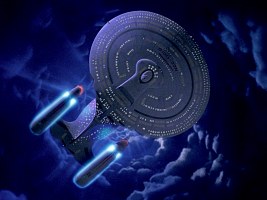
 Vortex in TNG-R: "Time Squared"
Vortex in TNG-R: "Time Squared"